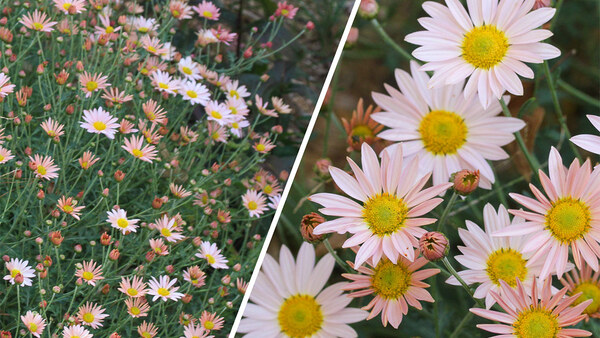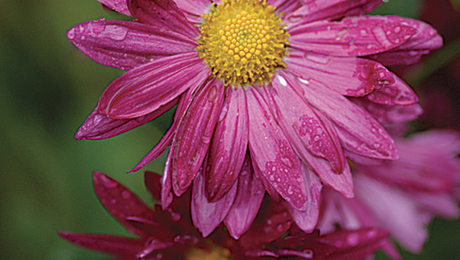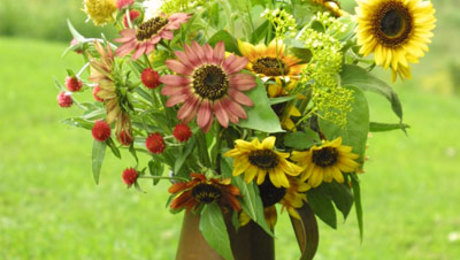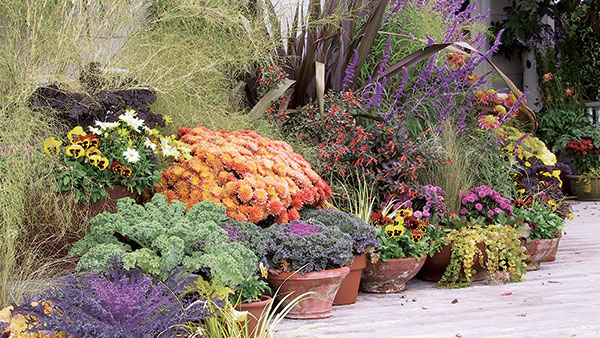
Photo/Illustration: Chris Curless
As the days of summer grow shorter and cooler, fall chrysanthemums burst into bloom for a grand finale to the garden year. In rich shades of russet, purple, deep red, soft pink or glowing gold, the flowers of garden mums offer a glorious complement to the bounty of the harvest and the vivid foliage of fall.
Mums (Dendranthema grandiflora, formerly Chrysanthemum morifolium) have been grown in gardens for hundreds of years, but only in the last decade have breeders concentrated on making them better plants for the home garden, rather than for the cut-flower industry. Mums for landscape use are often called garden mums.
Ever since I first grew them, mums have been part of my home gardens and my work. Their variations of color and form sparked my interest when I was 16 years old, and I’ve grown many mums since. Now my work takes me all over the U.S. and Canada, where I can see first-hand how different cultivars fare.
Garden mums offer a style to fit almost any garden. Plant them anywhere that cries out for a spectacular splash of color. They extend the gardening season for weeks, thrive across most of the country and their cultural needs are simple.
Many gardeners are accustomed to thinking of mums as annuals. It is easy to grow them as annuals, but with some planning, they also can be successfully overwintered in cold climates for year after year of bloom.
Choosing mums
Garden mums are photoperiodic, meaning they bloom in response to shorter days and longer nights. A night length of 12 hours tends to trigger bud formation. Cooler night temperatures also encourage blooming. September through October is when garden mums are in their glory, but the flowering season actually begins in late summer and continues until heavy frost, sometimes as late as November.
Individual flowers on the plants can last from three to six weeks High temperatures and lack of water shorten the flowering period. Most garden mums can withstand several light frosts, but those with white flowers often show damage after just one frost.
Color and size
Garden mums are available in an exciting array of colors–yellows from delicate creamy pastels to brilliant deep gold; soft pinks and lavenders; bright pinks and purples, dark reds, ivory, pure white, and bronze tones. Some lavender, bronze and yellow mums have two-toned color patterns. One of my favorite mum colors is coral, a rarity until several years ago. ‘Grenadine’ is now a widely available coral mum.
Mum plants range in size and shape from low, tight mounds to tall plants with a looser habit. Those with a mounded, pincushion-like habit, usually no more than 20 in. tall, are referred to as cushion mums. They’re well suited for gardens, because they dont topple over or require staking as taller mums sometimes do.
The flowers of mums also come in many shapes and sizes, from tiny, tight buttons to daisies to long, curling spiders. My experience is that the decorative flower types, which bear many-petaled flowers that are flat or slightly crested in the center, are the most durable and retain their color better in the garden, but you might enjoy trywing the others.
Tried and true cultivars

Photo/Illustration: Richard Shiell
The following is a small selection of cushion garden mums I’ve found particularly reliable. Most are readily available from local nurseries in the fall; many can also be ordered by mail.
One of the finest garden mums is a brilliant yellow decorative named ‘Jessica’, which flowers in mid-September. This cultivar can take the summer heat in the South, and it is covered with some of the longest-lasting flowers around.
‘Lynn’ is a beautiful two-tone decorative with a center of dark lavenderalmost purpleand outer petals of clear, bright lavender. The plants have a superb cushion habit, with very dark green foliage, and are ideal for borders, edgings or containers.
One of the most popular garden mums is a dark lavender decorative called ‘Debonair’, which has very formal flowers on a strong plant with dark green foliage.
Minn-Autumn, an old-timer with large, rust-red decorative flowers, developed at the University of Minnesota. Like other cultivars whose names begin with Minn, it’s an early flowering, cold-hardy plant and is especially suited for cold-winter climates.

Photo/Illustration: Chris Curless
My favorite all-around red mum is ‘Bravo’. Its bright red, decorative-type flowers are gorgeous when fresh, although the outer flowers lose their color and fade to a brownish-red as they age.
Among the best performing white cultivars are ‘Linda’, an ivory white decorative, and ‘Illusion’, a prolific and showy quilled daisy, whose long, tubular outer flowers radiate from a central disc, giving this cultivar a dainty appearance.
‘Naomi’ is a daisy with spoon-tipped, tubular petals that are lavender on the outside and silvery-pink on the inside, with a light green central eye. In warmer parts of country, the color is much lighter and more pink.
Getting started

Buying plants
You can buy mums as full-grown plants in bud and bloom in spring (they’ve been forced in a greenhouse to bloom early) and in fall, or as young plants started from cuttings, which are available mainly through mail-order catalogs in spring. Mail-order often gives the widest selection, but many gardeners enjoy the ritual of selecting mums locally in autumn. Buy mums when the flowers are just beginning to show color so youll be able to enjoy the daily changes as the petals unfurl.
Spring-planted mums have the best chance of successfully overwintering in cold climates. There, plant mums anytime after the frost-free date in spring through mid- to late July. If you buy young plants by mail, order them early enough for the spring shipping.
If you buy garden mums in flower in spring, you can put them on your kitchen table and enjoy the blooms for a couple of weeks, then transplant them to the garden when flowers fade and danger of frost has passed. Prune them back to 1/3 to 1/2 of their flowering height and care for them as described below. They’ll reward you with another burst of color in the fall.
Cultural needs
A stunning display of bloom is practically guaranteed if you plant mums in fall and treat them as annuals. All you have to do is pop them into the ground or leave them in their pots and remember to water them during dry spells. If you want to grow mums as perennials, however, provide plenty of sun, fertile soil and regular pinching.
Garden mums do best in full sun. With less than half a day of sun, their stems grow lanky and topple under the weight of the flowers. Foliar disease is also more likely to develop in too much shade.
Be sure to plant mums at least 20 ft. away from street lights or other night lights. Upsetting the normal hours of darkness will throw the mum off schedule, and it may not flower.
Mums, which are generally shallow-rooted, like well-drained, yet moist soil that is slightly acid (the ideal soil pH is about 5.8 to 6.8). If their feet are wet, growth and flowering will suffer, and plants may die. Dig in organic matter such as peat moss, aged manure or compost for good moisture retention.
Mums should be well fertilized, but they arent very particular about the kind of fertilizer or its formulation. For spring- and summer-planted mums, incorporate an all-purpose granular fertilizer into the soil at planting time. Water in young spring transplants with a balanced liquid fertilizer, such as a 20-20-20 formulation, as soon as they are planted. Thereafter, feed monthly with granular or liquid fertilizer through mid- to late July to encourage vigorous growth. No fertilizer is necessary when planting in fall; just soak the soil with water.
Set young plants 18 in. to 24 in. apart to give them enough room to grow freely into a mound. If, however, the plants you buy in fall are small, you can plant them more closely in masses for greater impact.
Water regularly and deeply to keep the plants and flowers healthy. Plants can become painfully wilted and still spring back, but the stems will then be woodier and will branch less freely. Mulch to conserve moisture and to keep the soil cooler.

Photo/Illustration: Rosalind L. Wanke
Pinching
Garden mums grown as perennials must be pinched back during the spring and summer to encourage lateral branching and a sturdy, compact plant. Unpinched mums will bloom, but the plants will grow more open and flower less.
Spring-planted young mums will be ready for their first pinch a few weeks after planting. Older mumsoverwintered plants or potted mums planted out in spring after they’ve bloomedshould be pinched as soon as new shoots are 3 in. to 4 in. long. To pinch mums, grasp the growing tip and the first set of leaves on each shoot between your thumb and forefinger and nip them off, removing about 1/2 in. to 1 in. of stem. It’s neater to pinch above a node (the place on the stem from which leaves emerge), but not necessary. Pinched-back plants will rapidly push out new stems from these nodes. When the stems reach 3 in. to 4 in. long, pinch again.
The exact date for the last round of pinching depends on your climate and the type of mums you are growing. The plants must have several weeks to set buds after the final pinch. For early-season mums, or in northern gardens, finish pinching around July 10-15. In southern states, continue pinching until late July or, for very late blooming cultivars, up until August 15.
Overwintering mums in cold climates
Garden mums are often called hardy mums, but their hardiness is not always reliable, especially in northern gardens where, in my experience, the plants overwinter successfully only about half the time. Garden mums can be as fickle as roses when it comes to hardiness. Severe cold, repeated cycles of freezing and thawing, wet, heavy soil or lack of snow cover can also mean the end of a favorite plant. To avoid disappointment where winter survival can be a gamble, plant mums for the beauty of one season and consider it a bonus if they overwinter.
That said, Id like to give you some some tips to boost your chances of keeping mums as perennials. Avoid planting them in areas subject to cold, drying northerly or northwesterly winds. Plant cold-hardy mums, like those with cultivar names beginning with Minn. Stop fertilizing plants by the end of July to discourage new growth late in the season. To promote roots that are well established by winter, keep the soil moist, but not soggy, throughout the fall. After the soil freezes, add several inches of a loose mulch, such as straw or hay, around the plants to a depth of several inches. Wait until spring to cut the plants backthe stems will protect the crown (the place where the stems join the roots). I’ve also had success overwintering mums in containers by putting them in an unheated garage and keeping the soil barely moist.
You can count on three to four years of plentiful flowers before a mum plant needs renovation. To freshen a tired clump, divide it in spring when new shoots appear by digging out the clump, slicing it in half with a sharp spade, and replanting the new clumps.
Fine Gardening Recommended Products

Gardener's Supply Company Summerweight Fabric Plant Cover
Fine Gardening receives a commission for items purchased through links on this site, including Amazon Associates and other affiliate advertising programs.

The Nature of Oaks: The Rich Ecology of Our Most Essential Native Trees
Fine Gardening receives a commission for items purchased through links on this site, including Amazon Associates and other affiliate advertising programs.

Pruning Simplified: A Step-by-Step Guide to 50 Popular Trees and Shrubs
Fine Gardening receives a commission for items purchased through links on this site, including Amazon Associates and other affiliate advertising programs.


















Comments
Nice flower. I really liked it!
Thanks for sharing this info!
Liked it very much. keep it up!
It's so beautiful Flower. I really liked it!
I really liked it very much. Thanks for sharing this info!
It's very Informative! I love this post!
It's very Informative! Let me introduce myself. My name is Lacie, and I have taught English to primary and secondary age students for over 8 years. I have my Bachelor's Degree in English Education. I have taught beginning, intermediate, and advanced English as a second language to all age groups. I enjoy teaching all ages of learners including reading, writing, and speaking English. For my students I recommend this service https://essayreviewexpert.com/review/papersowl/ where you can read true reviews about papersowl. I also taught college English courses to high school age students and can help students prepare to take college entrance exams.
Very Nice! Thanks for sharing this post!
Good Job! Thanks for sharing this information
Hi, these flowers look really amazing and I also want to grow plant-like this in my garden. By the way, I am looking for business plan developers, If you know where I can get it then please let me know.
Thanks for sharing great content. Like writing Best Microfiber Cloth
Log in or create an account to post a comment.
Sign up Log in